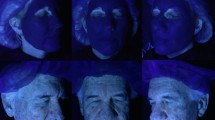Abstract
This study identified predictors of sunscreen use in males and females and examined the extent to which gender differences in sunscreen use were associated with skin cancer screening outcomes. Subjects were 351 adult Southern California residents who participated in one of five free skin cancer screenings. Logistic regression models showed that sunscreen use was significantly associated with sex, personal and family history of skin cancer, and a sun sensitivity index. The latter three factors were found to be confounders of the sex-sunscreen use relationship. Whereas female use of sunscreen was best predicted by her sun sensitivity, male use of sunscreen was best predicted by a family history of skin cancer. Screening outcomes also varied by sex, suggesting that the interrelationships among gender, family history of skin cancer, and sun sensitivity have important implications for sunscreen use, which may in turn impact clinical outcomes.
Similar content being viewed by others
References
Bandura, A. (1989). Human agency in social cognitive theory.Am. Psychol. 44: 1175–1184.
Berwick, M., Fine, J. A., and Bolognia, J. L. (1992). Sun exposure and sunscreen use following a community skin cancer screening.Prev. Med. 21: 302–310.
Biddle, S., Goudas, M., and Page, A. (1994). Social-psychological predictors of self-reported actual and intended physical activity in a university workforce sample.Br. J. Sp. Med. 28: 160–163.
Cody, R., and Lee, C. (1990). Behaviors, beliefs, and intentions in skin cancer prevention.J. Behav. Med. 13: 373–389.
Department of Community and Environmental Medicine, University of California at Irvine (1986).Cancer Surveillance Program of Orange County: Results—1984. Author, Irvine, CA.
Garland, C. F., Garland, F. C., and Gorham, E. D. (1992). Could sunscreens increase melanoma risk?AJPH 82: 614–615.
Garland, C. F., Garland, F. C., and Gorham, E. D. (1994). Re: Effect of sunscreens on UV radiation-induced enhancement of melanoma growth in mice.J. Natl. Cancer Inst. 86: 798.
Graham, S., Marshall, J., Haughey, B., Stoll, H., Zielesny, M., Brasure, J., and West, D. (1985). An inquiry into the epidemiology of melanoma.Am. J. Epidemiol. 122: 606–619.
Holman, C. D., and Armstrong, B. K. (1984). Pigmentary traits, ethnic origin, benign nevi, and family history as risk factors for cutaneous malignant melanoma.J. Natl. Cancer Inst. 72: 257–266.
Holman, C. D., Evans, P. R., Lumsden, G. J., and Armstrong B. K. (1984). The determinants of actinic skin damage: Problems of confounding among environmental and constitutional variables.Am. J. Epidemiol. 120: 414–422.
Holman, C. D., Armstrong, B. K., and Heenan, P. T. (1986). Relationship of cutaneous malignant melanoma to individual sunlight-exposure habits.J. Natl. Cancer Inst. 76: 403–414.
Hosmer, D. W., and Lemeshow, S. (1989).Applied Logistic Regression, John Wiley & Sons, New York.
Hunter, D. J., Colditz, G. A., Stampfer, M. J., Rosner, B., Willett, W. C., and Speizer, F. E. (1990). Risk factors for basal cell carcinoma in a prospective cohort of women.Ann. Epidemiol. 1: 13–23.
Janz, N. K., and Becker, M. H. (1984). The health belief model: A decade later.Health Educ. Q. 11: 1–47.
Johnson, E. Y., and Lookingbill, D. P. (1984). Sunscreen use and sun exposure.Arch. Dermatol. 120: 727–731.
Jones, J. L., and Leary, M. R. (1994). Effects of appearance-based admonitions against sun exposure on tanning intentions in young adults.Health Psychol. 13: 86–90.
Keesling, B., and Friedman, H. S. (1987). Psychosocial factors in sunbathing and sunscreen use.Health Psychol. 6: 477–493.
Koh, H. K., and Lew, R. A. (1994). Sunscreens and melanoma: Implications for prevention.J. Natl. Cancer Inst. 86: 78–79.
Leary, M. R., and Jones, J. L. (1993). The social psychology of tanning and sunscreen use: Self-presentational motives as a predictor of health risk.J. Appl. Soc. Psychol. 23: 1390–1406.
Mullen, P. D., Hersey, J. C., and Iversen, D. C. (1987). Health behavior models compared.Soc. Sci. Med. 24: 973–981.
O'Doherty, C. J., Prescott, R. J., White, H., McIntyre, M., and Hunter, J. A. (1986). Sex differences in presentation of cutaneous malignant melanoma and in survival from stage I disease.Cancer 58: 788–792.
Pathak, M. A. (1987). Sunscreens and their use in the preventive treatment of sunlight-induced skin damage.J. Dermatol. Surg. Oncol. 13: 739–750.
Rampen, F. H. (1984). Sex differences in survival from cutaneous melanoma.Int. J. Dermatol. 23: 444–452.
Ronis, D. L. (1992). Conditional health threats: Health beliefs, decisions, and behaviors among adults.Health Psychol. 11: 127–134.
Skolnick, A. (1991). Sunscreen protection controversy heats up.JAMA 265: 3218–3220.
Spilman, M. A. (1988). Gender differences in worksite health promotion activities.Soc. Sci. Med. 26: 525–535.
Thompson, S. C., Jolley, D., and Marks, R. (1993). Reduction of solar keratoses by regular sunscreen use.N. Engl. J. Med. 329: 1147–1151.
Thorn, M., Ponten, F., Bergstrom, R., Spaten, P., and Adami, H. (1994). Clinical and histopathologic predictors of survival in patients with malignant melanoma: A population-based study in Sweden.J. Natl. Cancer Inst. 86: 761–769.
Verbugge, L. M. (1985). Gender and health: An update on hypotheses and evidence.J. Health Soc. Behav. 26: 156–182.
Verbugge, L. M. (1989). The twain meet: Empirical explantation of sex differences in health and mortality.J. Health Soc. Behav. 30: 282–304.
Weinstein, N. D. (1988). The precaution adoption process.Health Psychol. 7: 355–386.
Weinstein, N. D. (1993). Testing four competing theories of health-protective behavior.Health Psychol. 12: 324–333.
Wichstrom, I. (1994). Predictors of Norwegian adolescents' sunbathing and use of sunscreen.Health Psychol. 13: 412–420.
Wolf, P., Donawho, C. K., and Kripke, M. L. (1994). Effect of sunscreens on UV radiation-induced enhancement of melanoma growth in mice.J. Natl. Cancer Inst. 186 99–105.
Author information
Authors and Affiliations
Rights and permissions
About this article
Cite this article
Hourani, L.L., LaFleur, B. Predictors of gender differences in sunscreen use and screening outcome among skin cancer screening participants. J Behav Med 18, 461–477 (1995). https://doi.org/10.1007/BF01904774
Accepted:
Issue Date:
DOI: https://doi.org/10.1007/BF01904774



